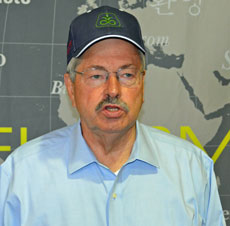In one year the acres planted in Enogen corn will expand from 100,000 acres in 2014 to more than 300,000 acres in 2015 and that means that ethanol production will be expanding too. To learn more about how Syngenta achieved this feat, I spoke with David Witherspoon, head of renewable fuels for Syngenta during Farm Progress. Not only are ethanol plants excited about Enogen corn (Syngenta donates $1 per acre planted to the renewable fuels industry), but corn farmers are excited about it as well – they receive a 40 cent premium. So assuming an average yield of 165 bushels an acre, Enogen corn will generate approximately $6.6 million of additional revenue for the local growers who have signed contracts in 2014.
What is interesting is that only 15 percent of a farmer’s acre is planted with Enogen corn because the “sweet” spot for ethanol production is 15 percent.  So how is Enogen different? As Witherspoon explained, the Enogen corn enzyme technology offers ethanol plants an opportunity to increase their per bushel ethanol production as well as improve energy efficiency during the production process.
So how is Enogen different? As Witherspoon explained, the Enogen corn enzyme technology offers ethanol plants an opportunity to increase their per bushel ethanol production as well as improve energy efficiency during the production process.
“The ethanol plant needs an enzyme for ethanol production at 15 percent and then this corn is mixed with the other corn that comes into the plant,” explained Witherspoon. “And the way we found this out is that we tested plants in the lab and looked at what the optimal dosage at that plant to get the maximum performance enzyme. And if we go higher than that, we found that we don’t need anymore.”
When you look at a farmer’s field growing Enogen corn you can’t tell the difference. The corn has the exact same benefits (pest control, disease control, etc.) that other Syngenta hybrids have.
Another application that Witherspoon said that Enogen corn is really excelling in is when used with the “ACE” technology, or Adding Cellulosic Ethanol, that separates the fiber from the corn kernel and produces cellulosic ethanol. It’s the first technology of its kind in the world and the Galva, Iowa plant went online with commercial scale cellulosic ethanol production this summer. Syngenta was so impressed with the technology that they have partnered with the plant to sell the technology.
So here’s the scoop. Several ethanol plants who are buying the Enogen corn have sold out their acres for the 2015 growing season but there are still a few acres left for some other ethanol plants. In addition, Witherspoon said there are quite a few farmers who would like to plant Enogen corn but need to partner with their local ethanol plant to implement the program. So, all ethanol plants that would like to pursue the program need to contact Syngenta soon to get in the program before it sells out this year. And if you are interested in seeing first-hand how Enogen corn performs, then come to the Quad County Corn Processors grand opening on September 9, 2014.
To learn more about Enogen corn and its benefits for farmers and for ethanol plants, listen to my interview with David Witherspoon: Interview with David Witherspoon
View the Farm Progress 2014 Flicker photo album.










